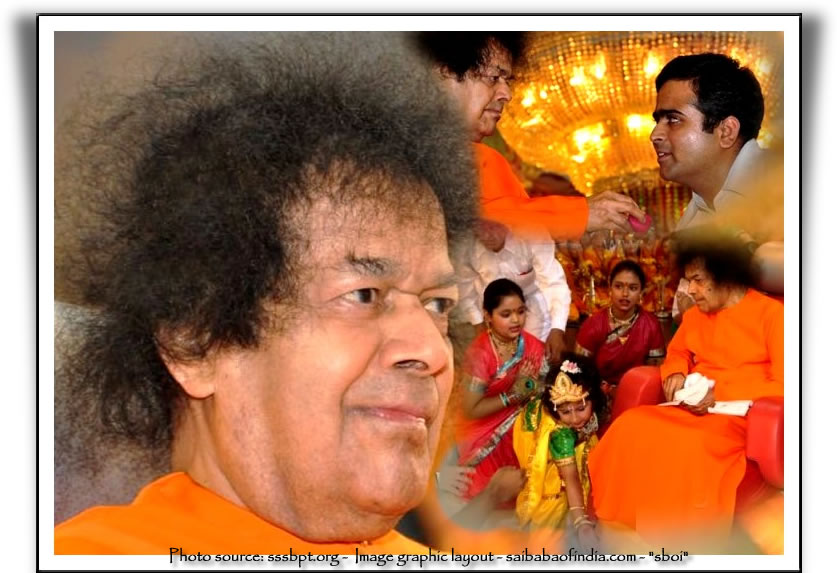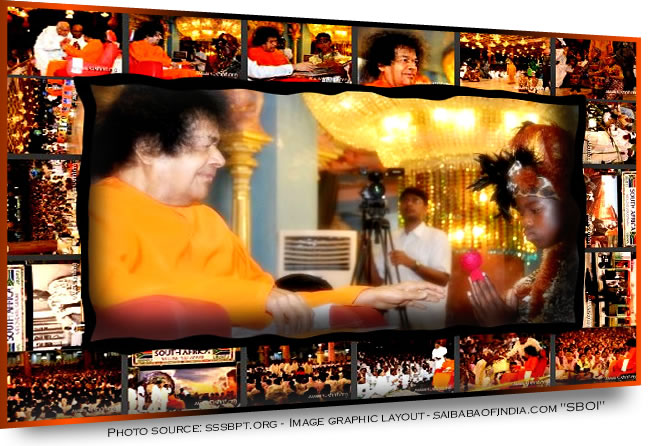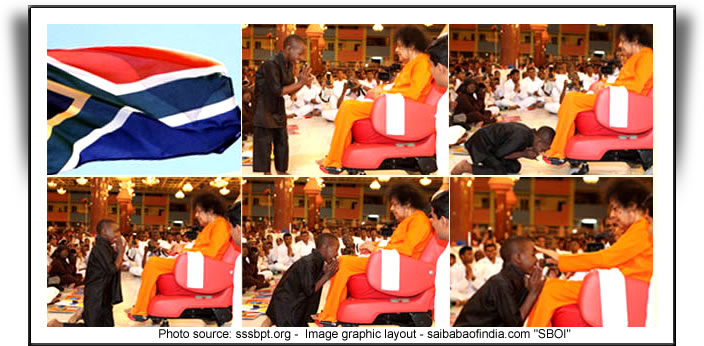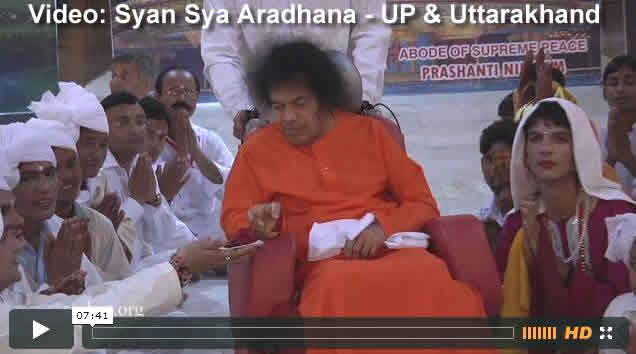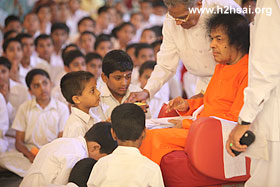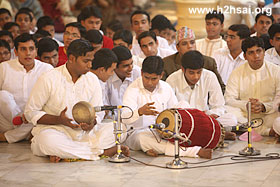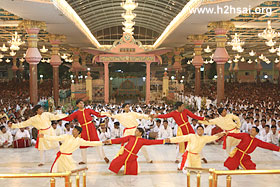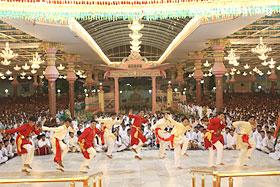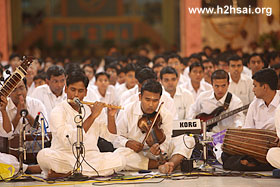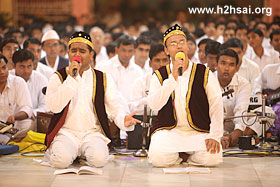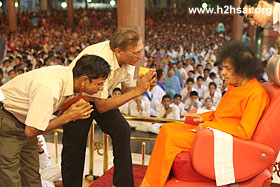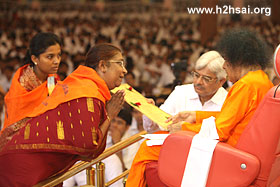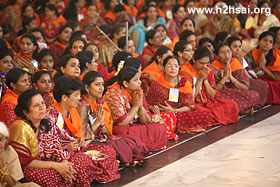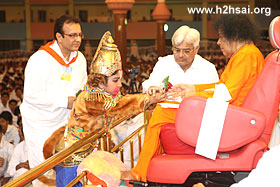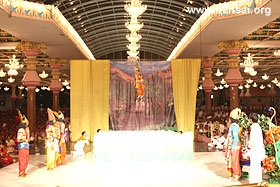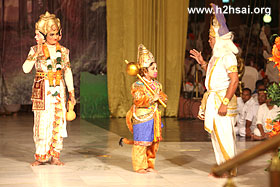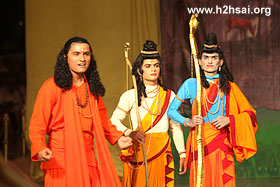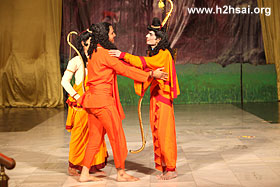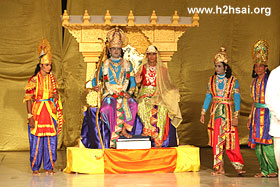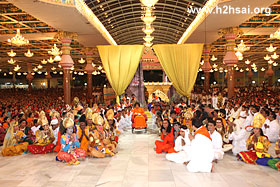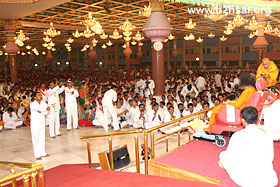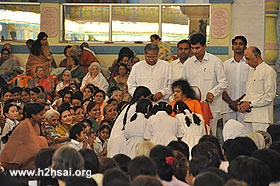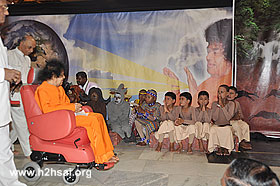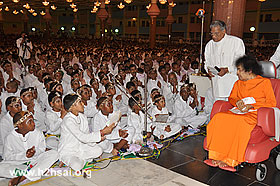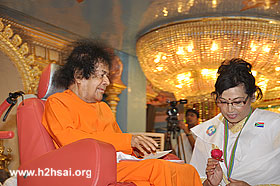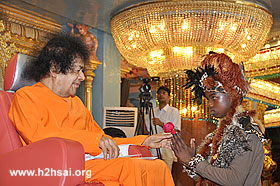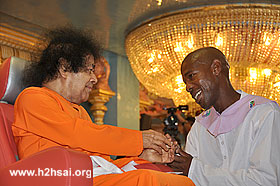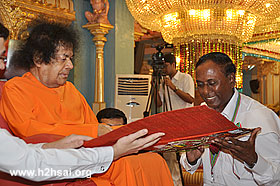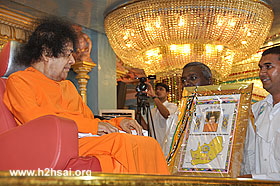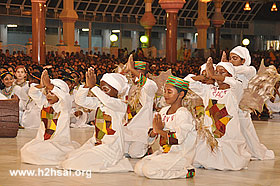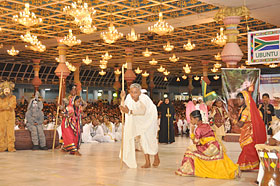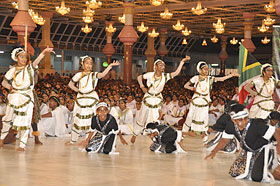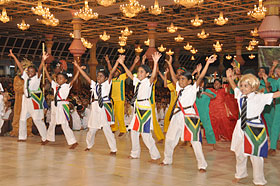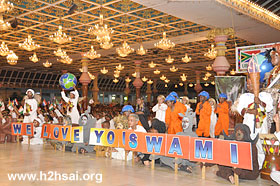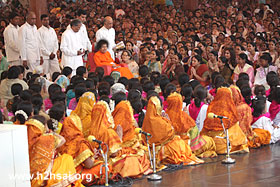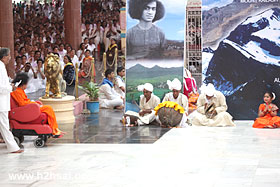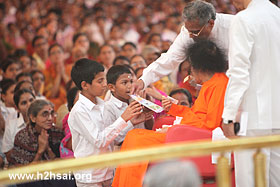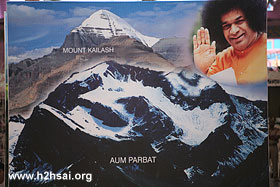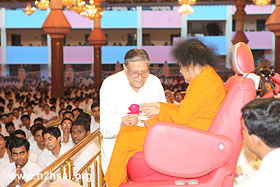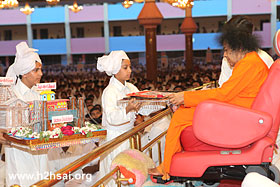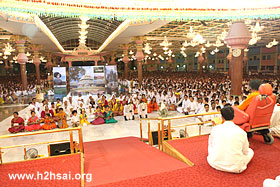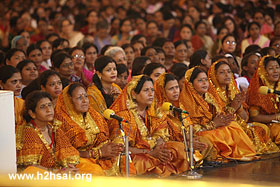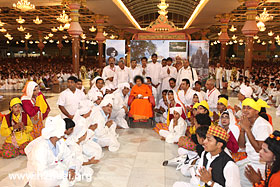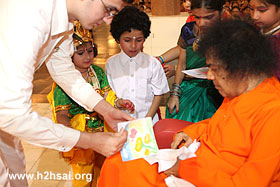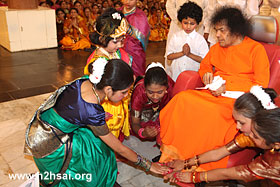|
||||||||||||||||||||||||||||||||||||
|
<< Aug. 2010 | Current Sai Baba News| Sep. 2010 >> - top of the page |
||||||||||||||||||||||||||||||||||||
|
In the evening, as Bhagawan entered the hall at 7:00, He was greeted by bhajans.
2400 Africans were seated in front block, with children occupying the
centre-slot. As He passed by these frontbenchers were blessed by His benedictory
glance. |
||||||||||||||||||||||||||||||||||||
|
|
||||||||||||||||||||||||||||||||||||
|
|
||||||||||||||||||||||||||||||||||||
|
web layout - photo design : saibabaofindia.com & SBOI group. |
||||||||||||||||||||||||||||||||||||
|
Syan Sya Aradhana....UP & Uttarakhand ...25 Sept 2010
|
||||||||||||||||||||||||||||||||||||
|
Text & photo source: sssbpt.org -
Sri Sathya Sai Media Foundation - |
||||||||||||||||||||||||||||||||||||
|
Voice of Unity....Students' Programme ...20 Sept
2010
|
||||||||||||||||||||||||||||||||||||
September 20, 2010 – “The Voice of Unity” by Sai StudentsThe team from the National Assessment and Accreditation Council or the NAAC as it is called had arrived to Puttaparthi to accredit Sri Sathya Sai Institute of Higher Learning. For those who know the reality, this whole exercise seems so strange. What do this mean?
Simply this: When Swami started the Institute, during the first Convocation on the 22nd of November 1981, He had said, “Students! You are aware that there are now 108 universities in India. This University is the 109th, one more than that traditional total. Lokaah samastaah sukhino bhavanthu - May all the universities succeed and serve the country well. But, this university must be distinct from the rest and attain a unique status. It must be the ideal for others. For this consummation students, teachers, parents, rulers and the people must cooperate.”
So,the very basis for starting the University was that it stands out different from all the existing ones. But that day, a team had arrived to see how the university is faring based on parameters used to judge any other University (!) with the question in mind, “Why make a special exception for this University?” A rich history of such teams visiting Puttaparthi has always shown people arriving with their heads held high, full of questions but returning with hearts full and heads bent low, filled with wisdom and humility!
The team had visited the various departments of the Institute and had queried them on many issues. The answers were given with a lot of conviction. It is an interesting story in itself to cover this transformative process of a visiting team, but leaving that for some other time and space, we proceed to the events of the day in the Mandir. The team was blessed to witness a cultural programme which Swami had blessed the students to put up in front of Him.
Swami had not come out for darshan the previous day and so that day there seemed to be a lot of prayers for His arrival. When Swami finally arrived at about 6:25 p.m., there was a surge of joy amongst the waiting people. On both sides, people rose to their feet and cried out in joy as Swami passed by. It is so true that when we miss something, we realize its importance instantaneously. Blessing the birthday boys, Swami arrived on the stage. He sat listening to the bhajans and began to leaf through the day’s mail! His not coming the previous day seemed to have proportionally increased His mail too! After about 25 minutes of bhajans, the student next to Swami asked Swami about the programme and Swami told the students to start.
One boy quickly moved up the stage and offered a rose to Swami and the programme entitled, “The Voice of Unity” began. Commencing with an introduction on the salient features of the esteemed Institute, the students presented a Carnatic piece of Saint Thyagaraja, "Ramanannu Brovara...", rendered with professional touch. The next was a dance on the theme, “Mera Bharat Mahaan.” The verve and energy with which the boys danced drew applause from the appreciative audience.
Swami somehow was engrossed in the letters with only casual looks now and then at the programme. But the moment any boy rose to speak, Swami would be all ears for him. There was a wonderful and fast instrumental piece, the original of which has been played by Ronu Majumdar entitled Bengal Nagpur express. Interspersed in the piece were short speeches by students in various languages.
As the Sitar, Violin and Flute in the piece began to build a wonderful crescendo, there were goosebumps for many. There was the famous qawwali, “Sai Ke Darbar Mein” and the final topping came with the evergreen classic, “Humko Tumse Pyaar Kitna.” Electrifying the evening, airing lofty themes of national integration, hailing the alma mater, this reservoir of great talent and devotion, dedicated the presentation to their Divine Chancellor in presence of a visiting NAAC Team (National Assessment and Accreditation Council), an autonomous institution established by the University Grants Commission (UGC).
As the programme concluded, Swami asked for the aarthi to begin. Once that was over, Swami asked for the Samastha Lokaha… mantra to be chanted again after which He raised both His hands in blessings to all. As Swami moved towards the residence, all the members of the visiting NAAC team sought His blessings and touched His feet in reverence.
|
||||||||||||||||||||||||||||||||||||
|
web layout - photo design : saibabaofindia.com & SBOI group. |
||||||||||||||||||||||||||||||||||||
| top | ||||||||||||||||||||||||||||||||||||
|
|
||||||||||||||||||||||||||||||||||||
| Anjaneya Veera -Maharashtra & Goa presentation 30 Sept 2010 | ||||||||||||||||||||||||||||||||||||
| Published on Saturday, Oct 2, 2010 @ 1745 hrs. IST Over 2000 Youth from the twin states of Maharashtra & Goa, men and women, are in Parthi on a three days pilgrimage 30th Sept to 2nd Oct 2010 with a main agenda of successful implementation of Sri Sathya Sai Village Integrated Programme (SSSVIP) in the districts of Maharashtra & Goa. The youth had identified four core tasks for selected villages after meticulous survey. The core tasks identified were sanitation, construction of gramin seva kendra, bal vikas, mother & child care. The Parthi Yatra 2010 was organised after making substantial progress in the identified areas of activities. On the 30th Sept evening, the Maharashtra-Goa session began with youth representatives from various districts presenting reports of activities taken up, seeking Bhagawan’s benediction. Men in pairs followed by women forayed to the centre stage presenting brochures detailing various activities. This was followed by the main programme for the evening, a dance drama, “Anjaneya Veera”, presented by the Youth of Akola district of Maharashtra. The drama opens with a Youth mesmerized by bhajans recalling that wherever the glory of Rama is sung, there Hanuman is always present. The Youth thinks that in the pristine precincts of Prasanthi Nilayam, where Lord Rama Himself resides, Hanuman would certainly be present. And indeed, the greatest devotee of the Lord appears. Lord Rama Himself arriving at the scene volunteering to talk about the Glory of His chosen devotee, saying that it was His Will that He would narrate the story of Hanuman this day, against the normal practice, of Hanuman singing Rama's glory incessantly. Thus began the evening’s odyssey with Bhakta Hanuman. The one hour presentation began with Lord Rama the tale of Hanuman's mysterious birth with the blessing of Wind God. Vividly recollecting how Hanuman got the name Anjenaya, Kesari Nandan and Pavanputra, the narration went on with the enthralling incident in which young Bajrang Bali reaches out towards the Sun thinking it to be a fruit, inviting the wrath of Lord Indra. Indra engages Hanuman in a battle and finally defeats him with the Vajra. In an act of revenge against the atrocity meted out to his son, Wind God withdraws all air from earth, leaving panic in Indra’s court. Devas rush to make amends granting extraordinary powers to Hanuman. His broken jaw at the hands of Indra gave him the name Hanuman by which He would be most remembered for all time to come.
more details below....
|
||||||||||||||||||||||||||||||||||||
|
September 30, 2010 – Drama on Hanuman by Maharastra and Goa The final day of the ninth month of 2010 had the devotees from the states of Maharashtra and Goa assembling in the Sai Kulwant Hall to stage their programme. As per the latest instructions from Swami, bhajans began at 5:30 p.m. after the conclusion of the Veda chanting. The whole hall was immersed in devotional singing and it was at 6:30 p.m. that Swami arrived.
Bhagavan took a complete round and arrived on the stage via the portico. On the stage He lit a lamp and then sat at his place. He began to read the letters that He had collected and they were quite a good number. He seemed to be enjoying the bhajans that were going on as He lightly tapped his feet to rhythm with them and kept reading the letters.
The co-ordinators were worried about their programme and in their own were inwardly praying and trying to attract His attention. Man’s ways are indeed funny. He seems to have more faith when physically away from god rather than when He is close! As Swami had said in one of His discourses, “When one speaks of the mango, the mouth begins to water. But when the same person is given one in his hand, the mango is checked for worms and tested for taste! So too with God. Man has implicit faith in the name but when the form comes, man always seems to have doubts!”
Swami read letters till 7:20 p.m. and then asked the bhajans to be stopped. Looking at the youth seated at the far end of the marbled blocks, He told them to begin their presentation. Now there was a different kind of a start to the programme - representative youth from the various districts of Maharashtra made a beeline to the stage to present Swami a rose and a brochure of the service activities of the district. This was followed by the members from the ladies’ side too.
As all this went on, songs were sung by the youth. There are always two different ways to view something. In one light this seemed as a wonderful way for so many members of the youth to get a close glimpse of Swami. It also gave an opportunity for the youth from all over Maharashtra to sing out their hearts to Him. They had travelled hundreds of miles to ensure group practices and a lot of effort had gone into preparing a music programme. But this 15 minute affair also meant that physically Swami would have to stay on for quite late that evening! And it was already more than an hour or so since He had arrived! Swami sat patiently blessing everyone who came to Him and once that was complete, He again asked for the drama to begin. The programme for the evening, a dance drama entitled Anjaneya Veera, was presented by the Youth and Balvikas from Akola district of Maharashtra. The seventy minute presentation began with Lord Rama telling Hanuman, “The world has heard you sing my glories. Today I wish to sing your glories!” And then the Lord begins to tell the story of His devotee to a Hanuman devotee! Hanuman, being mischievous, mistakes the sun to be an orange and tries to catch it.
Lord Indra brings him down with the thunderbolt after which his infuriated father withdraws the wind from the world. To pacify him, the Gods bless Hanuman with various capabilities. They also depicted the episodes of Hanuman’s tutelage under the Sun God, his initiation into the Rama Mantra, his valiant leap across the ocean to find Mother Sita, his desire to serve Rama with the service of snapping the fingers when Rama yawns and his absolute humility. The drama meandered and some scenes from the lives of saint Tulsidas and saint Bhadrachala Ramadas also were somehow stitched in.
The highlight of the drama was when Lord Rama offers Hanuman salvation or moksha and gets the reply, “Oh Lord! I’d rather live in this body that has been sanctified by your touch than get liberated!” In the middle of the drama, there was also a mini drama when the pigeons from the rooftop littered the marble with droppings. One of the students went forward and cleaned the slab with a piece of paper.
Swami continuously watched him and let out a smile! The youth everywhere waved saffron flags as the finale was sung. Once the drama concluded, Swami moved down the stage and posed with the youth for photographs. Moving up the stage, He immediately asked for aarthi. He also blessed prasadam for distribution. Calling the co-ordinators He said, “The theme of the drama was good. The drama was done well!” He was happy with the children who had done the drama and He showed that by raising both His hands in abhayahastha before retiring at 9 p.m. |
||||||||||||||||||||||||||||||||||||
|
September 28, 2010 – ‘Ubuntu’ Programme by South African Sai Devotees There were a flood of devotees from South Africa in Puttaparthi in the last week of September. More than 2500 devotees had arrived and were ready with a programme that featured hundreds of children. And so, when Swami gave permission for their programme to be put up on Sep 28, Sai Kulwant Hall seemed to transform itself into the heart of Africa - for the hearts from Africa had arrived and in large numbers too! There were purple scarves everywhere and a rolling backdrop had been erected. Hundreds of kids were behind this prop and a representative sample sat in front of it. The children’s choir adorned either sides of the marbled block and beyond them were the ladies’ and gents’ choirs. They were in complete readiness by 4:30 p.m. As they waited for Swami, they engaged themselves in chanting the Sai Gayatri.
It was 7:00 p.m. when Swami arrived for darshan. The sun had definitely set but the ‘Darling Figure in Orange’ seemed to bring in light as He glided into the hall. Faces lit up and the fatigue of being in a state of alertness from hours simply seemed to vanish. Swami was all smiles as He moved in for darshan. He blessed the girls from the Primary school and arrived at the centre. The concept being portrayed that day was the spirit of Ubuntu in South Africa. Ubuntu pronounced as oo-boon-too is an ethic or humanist philosophy focusing on people's allegiances and relations with each other. The word has its origin in the Bantu languages of southern Africa. The word literally translates into, “I am because you are and you are because I am!” That is the founding philosophy of the South African nation.
Swami then moved through the gents’ side. Bhajans were on and Swami arrived on the stage after taking a round through the portico. A broad smile came over His face as He turned to the students and said, “They (have come from) South Africa!” He seemed delighted. Immediately He asked for the programme to begin. The co-ordinators offered their salutations to Swami and the various representatives from the gents’ and ladies’ side went up the stage to make offerings. Swami blessed the various items. He accepted the offered roses and gifted the people with padanamaskar.
A girl then presented Swami with an album that contained letters written by the children. Swami began to leaf through it. The student by His side aided Him by turning pages. At one point, when he turned five or six pages together, Swami seemed to scold him and told him to turn only one page at a time. “These are letters they have written”, He explained so sweetly! Once that was done, He asked for the programme to begin.
Essaying the beautiful story of Unity in Diversity, the fifty minute presentation ran through the historical time of evolution of the nation beginning from immigration of the tribals, the Europeans and the Indians to the dark days of apartheid which concluded in what the nation was in the present times. It was presented by a chieftain of a tribe and his audience in the play were the animals of the continent - the cheetah, elephant, lion, rhino and buffalo. When each of these animals made their cries, Swami was so amused. The child in Him seemed to jump out as He laughed heartily. The various tribes of South Africa - the Maasai, the Zulu, the Ashanti - were all presented. Then the invasions by the foreigners were depicted. The beauty in this presentation was that it was never said that these foreigners depleted or destroyed Africa. Instead, they proclaimed, “There were troubled times but it was these times that enriched the culture of the nation!”
The episode of Mahatma Gandhi involving himself in the struggle against apartheid was also presented. There was a coal miners’ dance set during these times and seeing the natives dance with energy and joy, Swami was once again smiling and was so very happy. There were eleven songs in all and this included their national anthem and the various folk medleys. While the children in the centre depicted and danced, the ones from the choir swayed and moved their hands lending more meaning and festivity to the atmosphere. There were four conductors in all and they went about their job with clockwork efficiency. Swami kept looking at these conductors once in a while and the sweet game that He played was such that when they turned to look at Him, He seemed to look away!
The African drums and instruments made their appearance. However, there was also a song in classical Carnatic style with a dance when they depicted the arrival of the Indians to their nation. On the whole, it was a charged and filled 50 minutes. The concluding song celebrated the spirit of Ubuntu in South Africa and children waving flags of all the countries in the world formed a massive formation. The whole of the marbled blocks was populated with the 350 odd children who had participated in the programme. Even as they concluded, Swami said that He would move down into their midst. It was asked of Him, “Swami, should we segregate the girls and boys?” The gathering was so huge and Swami said, “No! I will go amidst them as the formation stands now.”
Moving down, Swami blessed all the participants with group photos. He asked many of them their names. He just seemed to be giving Himself to them. Even after the photo session, Swami did not moved up the stage, He sat down in their midst and asked them to sing bhajans. He distributed prasadam from His own hands. There was one very beautiful moment here. One boy on a wheel chair just got up and came skipping to Swami. He bent down and took namaskar. There was a smile on his face. Swami called him closer and touched him on his head. That touch threw him into a bout of extreme delight that he got up and almost danced his way back. It was such a beautiful sight to see and it is every time a wonderful sight to see someone touched by God! Swami then moved up the stage and asked for aarthi. As the aarthi was taken, Swami called one little girl who was crying and presented her with the print of the group photo that had been taken.
The girl gave Him a bundle of letters which He accepted. As she returned to her place, one more girl gave her a letter. In all her innocence, she simply walked up the stage and gave the letter to Swami. And Swami also simply accepted it! It was so sweet and done so simply - approach God with childlike simplicity and He too reflects the same! Swami then blessed everyone seated in front and then told all of them to go and eat well, and this elicited hearty laughter from all. After this, He retired for the day. It was 9 p.m. |
||||||||||||||||||||||||||||||||||||
|
September 25, 2010 – “Syan Sya Aradhana” by Devotees from UP amd Uttarakhand Devotees from the twin states of Uttar Pradesh and Uttarakhand were in Puttaparthi in the last week of September to present a programme as part of the 85th Birthday celebrations.
The backdrop was in position and at 5:35 p.m., Swami made His appearance. Accompanying the Veda chants was the beating of the traditional drums from the state. Men and women dressed in the traditional attires sat on either stage of the marbled area which would act as a stage for the programme they had come prepared with which was - "Syan Sya Aradhana" - a dance drama. Swami moved through the gents’ side and then as He went through the portico, a conifer sapling in a pot was brought to the front and placed for worship.
Swami arrived on the stage and kept watching the potted plant for a while. He gazed around and seeing some capped people with musical instruments, called and asked the Secretary, “Who are those people with the music instruments?” “Swami, as part of their programme, they also have live singing of some songs and so they are seated there,” was the answer. Swami nodded and then began to browse through the letters.
After about ten minutes, He looked up and suddenly seemed worried that He had spent too much time and the programme was getting delayed. With a look of urgency, He asked for the Veda chanting to conclude and blessed the programme to begin. He called over the State President and told him to commence the presentation.
This was followed by a group of children in special priestly attire, who came unto him with a temple structure, a depiction of cultural and spiritual heritage of the twin states. As the State President went on explaining various religious centres illustrated, Swami remained keen, listening to and watching over.
The play was based on the cultural traditions of northern region of Kumaon Mandal in Uttarakhand. The drama began with a prayer and ritual to Syan Sya, the Supreme Lord, portrayed in traditional folklore. Many traditional dances were showcased and stitched together with a conversation between the people of the land. The episode of how little Sathya stopped the rains which were threatening to swallow Puttaparthi was also presented.
The highlight however was a harvest dance, the Krishi Nritya, which featured mainly a farmer with two of his bullocks. The “bullocks” with their masks and posture elicited laughter from Swami. The farmer too was so desperate to get his bullocks under control and Swami turned to His side and laughed along with the students there! The Jodha Dance, a temple dance prayer to Mother Goddess received rounds of applause from the capacity audience. The finale was via a resolution by all to follow His teachings as placards conveying those teachings were displayed.
Once the final formation was made, Swami moved down the stage. He posed for photographs with the boys and collected letters from a few of them. He also allowed them to take padanamaskar. Then, He moved over to the girls. They were only about 7 in number and Swami posed with them too. He asked one little girl her name and as she responded in a squeaky voice, Swami asked, “What!? Bhargav?” The other girls responded, “Swami, Bhargavi!” Swami smiled and patting her on the head moved up the stage. He then had safari pieces and sarees distributed to all. Seeing the dancers in women’s dress, He asked, “Shouldn’t they be given sarees?” Those nearby smiled and answered, “Swami they are boys too!”
Swami told the student by His side to get shirt and pant pieces for the little boys who were seated in the front in the formation. He also blessed laddoo prasadam to be distributed to all. At 7:15 p.m. Swami received aarthi. The boy who offered a rose to him was involved in an animated and intense discussion with Him. After about 5 minutes, the conversation between the student and Swami seemed to conclude. Swami blessed everyone and then retired for the day.
|
||||||||||||||||||||||||||||||||||||
| top | ||||||||||||||||||||||||||||||||||||
|
web layout - photo design : saibabaofindia.com & SBOI group. |
